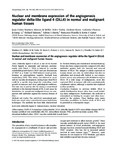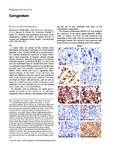Nuclear and membrane expression of the angiogenesis regulator delta-like ligand 4 (DLL4) in normal and malignant human tissues.
| dc.contributor.author | Martinez, JC | en |
| dc.contributor.author | Müller, MM | en |
| dc.contributor.author | Turley, H | en |
| dc.contributor.author | Steers, G | en |
| dc.contributor.author | Choteau, L | en |
| dc.contributor.author | Li, J-L | en |
| dc.contributor.author | Sainson, R | en |
| dc.contributor.author | Harris, AL | en |
| dc.contributor.author | Pezzella, F | en |
| dc.contributor.author | Gatter, KC | en |
| dc.date.accessioned | 2017-11-27T16:52:13Z | |
| dc.date.available | 2017-11-27T16:52:13Z | |
| dc.date.issued | 2009-04 | en |
| dc.identifier.uri | http://hdl.handle.net/10026.1/10315 | |
| dc.description.abstract |
AIMS: Delta-like ligand 4 (DLL4) is one of five known Notch ligands in mammals and interacts predominantly with Notch 1. DLL4 is induced by vascular endothelial growth factor (VEGF) and acts downstream of VEGF as a 'brake' on VEGF-induced vessel growth, forming an autoregulatory negative feedback loop inactivating VEGF. This action was believed to occur only in vascular development, raising hopes that DLL4 could be a specific drug target for controlling vessel growth in tumours and other pathological conditions. Our aim was to pursue this by raising a monoclonal antibody to the internal domain of DLL4 and assess its distribution in normal and malignant tissues in comparison with antibodies against the external domain of DLL4. METHODS AND RESULTS: The anti-DLL4 monoclonal antibody was raised using conventional mouse hybridoma techniques. The antibody has been fully characterized by Western blotting and transfectant immunostaining. It has also been comprehensively compared with other antibodies against both the internal and external domains of DLL4. The antigen is widely expressed on human tissues not only on endothelium but also on epithelium and stromal cells. Indeed, in our comprehensive survey only pulmonary alveoli failed to express DLL4. Of a wide range of malignancies, most also expressed DLL4 on tumour cells with a predominantly cytoplasmic pattern, although a number also displayed nuclear positivity. CONCLUSIONS: Contrary to previous beliefs, DLL4 is widely distributed in tissues other than vessels including many malignancies. Furthermore, the molecule is internalized on binding its receptor and often transported to the nucleus. These findings raise many interesting possibilities for further study of DLL4 and its potential as a therapeutic target. | en |
| dc.format.extent | 598 - 606 | en |
| dc.language | eng | en |
| dc.language.iso | eng | en |
| dc.subject | Adaptor Proteins, Signal Transducing | en |
| dc.subject | Antibodies, Monoclonal | en |
| dc.subject | Antibody Specificity | en |
| dc.subject | Blotting, Western | en |
| dc.subject | Calcium-Binding Proteins | en |
| dc.subject | Cell Line, Tumor | en |
| dc.subject | Cell Membrane | en |
| dc.subject | Cell Nucleus | en |
| dc.subject | Endothelium, Vascular | en |
| dc.subject | Fluorescent Antibody Technique | en |
| dc.subject | Gene Expression | en |
| dc.subject | Humans | en |
| dc.subject | Immunohistochemistry | en |
| dc.subject | In Situ Hybridization | en |
| dc.subject | Intercellular Signaling Peptides and Proteins | en |
| dc.subject | Microscopy, Confocal | en |
| dc.subject | Neoplasms | en |
| dc.subject | Neovascularization, Pathologic | en |
| dc.subject | Recombinant Proteins | en |
| dc.subject | Tissue Array Analysis | en |
| dc.subject | Transfection | en |
| dc.title | Nuclear and membrane expression of the angiogenesis regulator delta-like ligand 4 (DLL4) in normal and malignant human tissues. | en |
| dc.type | Journal Article | |
| plymouth.author-url | https://www.ncbi.nlm.nih.gov/pubmed/19413639 | en |
| plymouth.issue | 5 | en |
| plymouth.volume | 54 | en |
| plymouth.publication-status | Published | en |
| plymouth.journal | Histopathology | en |
| dc.identifier.doi | 10.1111/j.1365-2559.2009.03279.x | en |
| plymouth.organisational-group | /Plymouth | |
| plymouth.organisational-group | /Plymouth/REF 2021 Researchers by UoA | |
| plymouth.organisational-group | /Plymouth/REF 2021 Researchers by UoA/UoA01 Clinical Medicine | |
| plymouth.organisational-group | /Plymouth/REF 2021 Researchers by UoA/UoA01 Clinical Medicine/UoA01 Clinical Medicine | |
| dc.publisher.place | England | en |
| dc.identifier.eissn | 1365-2559 | en |
| dc.rights.embargoperiod | Not known | en |
| rioxxterms.versionofrecord | 10.1111/j.1365-2559.2009.03279.x | en |
| rioxxterms.licenseref.uri | http://www.rioxx.net/licenses/all-rights-reserved | en |
| rioxxterms.type | Journal Article/Review | en |



